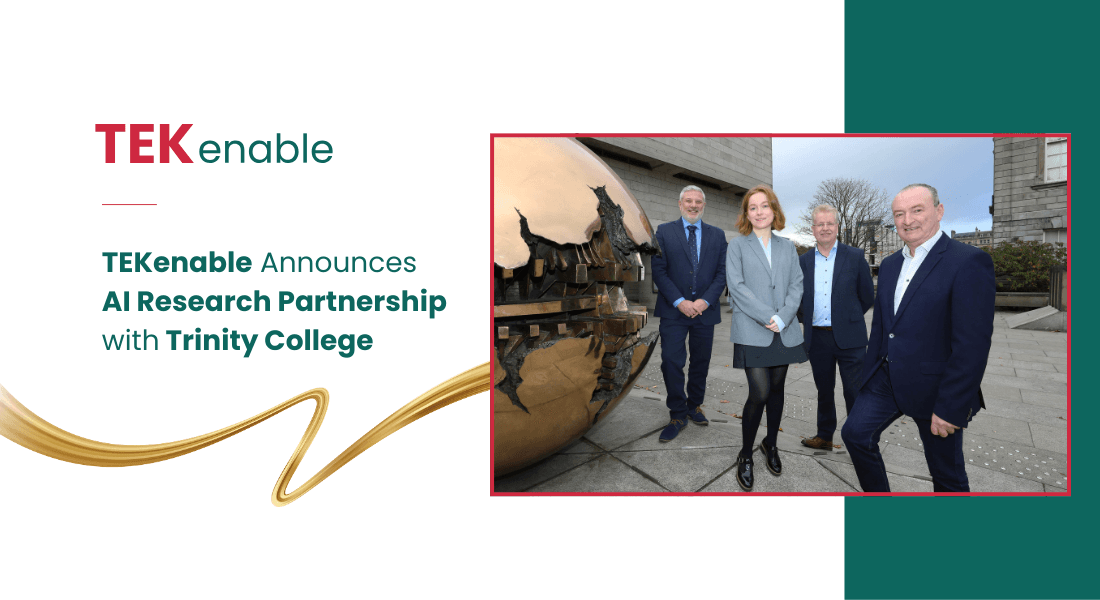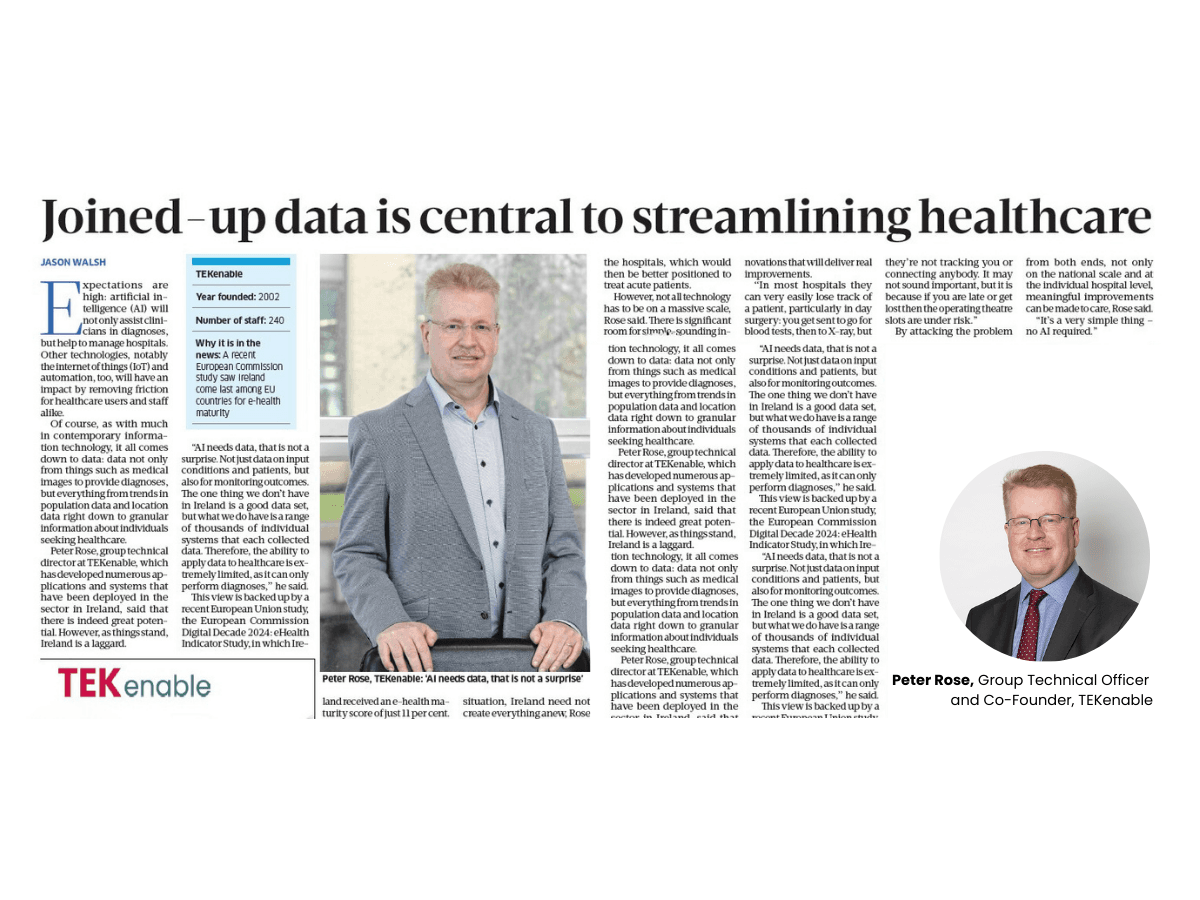Predictions about the future of artificial intelligence abound, but the technology is already being put to practical use in Ireland and abroad, writes Jason Walsh
Annette Soraine, Microsoft services director, TEKenable. ‘We’ve been doing AI workshops with a lot of our clients and prospects. We’re trying to remove the hype’
From a productivity boom to the job apocalypse, we all know what artificial intelligence (AI) will do in the future, or we think we do anyway.
It’s not just journalists or ‘thinkfluencers’ pontificating, either: financial markets, which slipped into the doldrums in 2022, have recovered in large part thanks to skyrocketing values for the likes of Microsoft, Nvidia, Broadcom, and even IBM. In other words, any business with a toehold in the technology, whether developing AI applications or banging out the chips it is expected to run on, is enjoying the attention of expectant investors.
Back on planet Earth, meanwhile, ChatGPT, the online chatbox unveiled by Microsoft partner OpenAI, has amused and confounded the world. But as the science fiction-inspired hype has settled down, questions have started to be asked about just how businesses can and should integrate AI into their operations.
Workers may be ahead of management on this front. In November, a survey conducted by Workhuman revealed that 30 per cent of Irish workers “frequently” used artificial intelligence (AI) tools in work, including, amusingly, over 20 per cent using it to help them ask for a promotion or raise.
Actually sanctioned use of AI is a real and growing part of Irish business as well.
In 2022, Bank of Ireland was among the winners at the annual AI Awards, taking home the gong for best application of AI in a large enterprise. In December 2023, meanwhile, the Business Post reported that Musgrave Group, parent of retailers SuperValu and Centra, was deploying AI-based automation technologies, including robots, as part of its €50 million investment in its Kilcock, Co Kildare distribution centre.
Chief supply chain officer Luke Hanlon said at the time that he could “definitely” see a growing role for automation and its integration has not been as complex or murky a process as many fear.
“Automation is still an early-stage technology in many industries and you can sometimes hear bad stories about how it doesn’t really work. But we’ve been very happy so far. Our experience has been the exact opposite of that,” he said.
Neither Irish outfit is alone. Managing wholesale and retail supply chains is an obvious application for AI, and giants such as Amazon are known to use it to forecast demand for products and to optimise inventory. Banking and financial services, meanwhile, has always been focused on data, and so is an obvious target for AI.
US banking giant JP Morgan Chase, for example, is working on a project called IndexGPT, a generative AI-based investment advisor. Perhaps more modestly, Dutch bank ABN Amro is using AI to summarise contact centre interaction, while Spain-based international bank Banco Bilbao Vizcaya Argentaria (BBVA) has also said it is exploring generative AI.
Moreover, as assisting software developers has emerged as arguably the leading application for generative AI, it is not entirely surprising that Goldman Sachs is experimenting with generative AI to augment internal coding and development.
One surprise, however, and one that garnered national media coverage, was the mention of An Post during Microsoft’s January 30 earnings call with investors.
“It [Copilot for Microsoft 365] is already being used by over 10,000 organisations including An Post, Holland America, PG&E,” said Microsoft chief executive Satya Nadella during the call.
Obviously, Microsoft, which recently revamped its AI offering with a focus on so-called ‘Copilot’ assistants, if not quite betting the farm, is at least pushing hard to take a leading position in the technology, hence its significant investment in ChatGPT creator OpenAI. Getting the nod from Microsoft during an earnings call, then, is quite the coup, but what is An Post actually doing with AI?
Chief technology officer Des Morley told Connected that the postal service was using AI in a range of applications centred on communicating with customers.
“One of the areas in which we are applying AI is to support our expert customer advice team who handle enquiries from personal and business customers on everything from financial services to customs payments and marketing mail campaign planning to outstanding parcels,” he said.
It is early days for An Post, but the focus is clearly on making the most of what Microsoft’s generative AI does best: turning raw information into useful conversation with humans.
“AI will help us to recall a customer’s case file, previous mail campaigns or logistics enquiries and provide faster, more thorough advice and care to all customers. We see it very much as a useful tool to assist staff, and allow them to spend more time helping customers and less time on admin,” he said.
But working to augment contact centres is not the limit of An Post’s ambitions. According to Morley, the organisation expects deeper integration of AI in the future.
“We’re also looking at the potential for AI in some exciting new products for personal customers and businesses. The possibilities are endless,” he said.
AI pioneers
Despite the excitement – and let’s be honest, hype – around AI, looked at in a certain way, the technology is nothing new. True, ChatGPT and its ilk do represent a major step forward, but there is a lot more to AI than writing.
Certainly, generative AI is getting the lion’s share of attention, particularly because chatbots seem to effectively mimic activities once vouchsafed for humanity, such as writing or drawing, but it is far from the only AI technology. For instance, machine learning (ML), which is a form of statistical analysis, has been used in fraud detection and spam filtering for some time.
However, what is intriguing many businesses about AI, and generative AI in particular, is not just the possibility of improving existing processes, but creating entirely new possibilities.
Audiostack, which has offices in Barcelona and London, and includes the likes of Porsche, McDonalds and Mountain Dew among its client roster, uses AI to speed up audio production workflows, something that has an obvious implication for advertising and marketing in the era of podcasting.
Founder and chief technology officer Peadar Coyle said that Audiostack’s software can not only reduce the amount of time it takes to create an audio advertisement, but allow for targeting at niches that would previously have gone ignored.
“We did localised campaigns, on a city level, for a German retailer. You couldn’t do that in the past, it was just too expensive,” he said.
In addition, Audiostack worked with News Corp Australia to transform real-time headlines into dynamic audio content and programmatically build 30-second ads that could be integrated into relevant podcasts.
On the strength of this technology, the company in February raised $3.1 million (€2.88 million) in series A funding.
Coyle does not see the technology resulting in machines doing the work of people.
“I think there will always be a human element – there’s always a creative step that’s needed – but, definitely, I think it could be part of the tool for brands the same way people use Adobe [software]. I think we’re going to see increasing vertical applications [for AI], whether it’s healthcare, whether it’s marketing.”
For businesses that do deploy AI, then, Coyle said the key will be to properly integrate it into workflows, starting with really understanding what people do and how they do it.
“One of the challenges is to understand how people do their jobs. There’s nothing worse than when a machine does something you don’t want to do and [then] you have to fight to overwrite it,” he said.
Dublin-based Visua, which is best known for developing technology used to detect phishing attempts by look and feel, is also allowing businesses to make sense of things that, in the past, had to be taken on trust.
“What we do is AI applied to images and videos. We have developed specific capabilities around interpreting large volumes of data,” said company co-founder Alessandro Prest.
Clients including Brandwatch and Vision Insights have used Visua’s AI to quantify things that were previously very difficult to pin down.
“Some things that are being done are: analysing sporting events to see, say, how many times a sponsor logo has appeared during a football game, for example, or analysing social media to understand how often a product or brand appears,” he said.
However, Prest said that while the possibilities are exciting, the current hype around AI runs the risk of masking the fact that AI is already part of everyday life, including business.
“These kinds of [AI] technologies have been around for a very long time. We were doing AI when it wasn’t cool, and a lot of us are interacting with AI systems on a daily basis without realising it,” he said.
Nevertheless, it is clear that virtually every business is now asking how it should respond to AI, and where specific use cases are not immediately obvious, AI, generative or otherwise, the question then is: will AI tech find a home at all?
Analysts certainly think so. In an October 2023 report, Gartner said it expected 80 per cent of enterprises to have incorporated AI by 2026.
Gartner VP analyst Arun Chandrasekaran said that the most common application today was what he called “text-to-x” and that this “democratises access for workers, to what used to be specialised tasks”.
However, Chandrasekaran also sounded a note of caution: “Organisations that do not consistently manage AI risks are exponentially inclined to experience adverse outcomes, such as project failures and breaches. Inaccurate, unethical or unintended AI outcomes, process errors and interference from malicious actors can result in security failures, financial and reputational loss or liability, and social harm,” he said in a press release.
So where does this leave anyone thinking about how they deploy AI without either breaking the bank or breaking the business?
Annette Soraine, Microsoft services director at software developer TEKenable, said that one of the company’s key goals is demystifying AI by showing what it is, what it is not, and, crucially, how a business case can be made for it.
“We’ve been doing AI workshops with a lot of our clients and prospects. We’re trying to remove the hype. People do feel they have to do something, but some are afraid of getting backed into a corner,” she said.
In practice, this means taking small steps that do not require declaring a kind of database Year Zero or a Big Bang re-architecting of every system that holds the information a business has collected.
“Something like knowledge mining and Copilots are a good introduction as you’re not going down the road of needing a new data structure. People are already using it in their personal lives for writing things like itineraries, so they are thinking ‘Surely there has to be an application for this in our business’,” she said.
Faced with the reality of board-level uncertainty, this left pockets of AI-led innovation in many businesses, according to Soraine.
This should be seen as a good place to start, though, she said.
“If you can get the wins early then you can have the bigger conversation. You can start with content creation, knowledge mining, and case summarisation, and then ask: ‘What’s the next step?’”
The above text was reproduced from the interview published in Business Post on February 21st, 2024.





